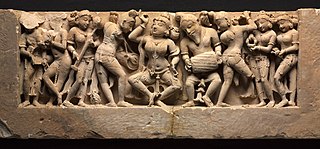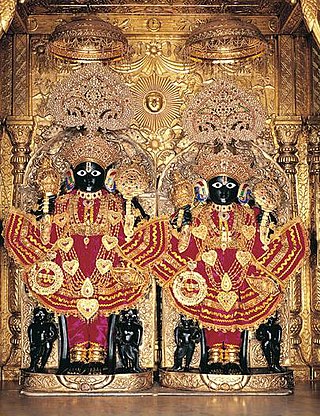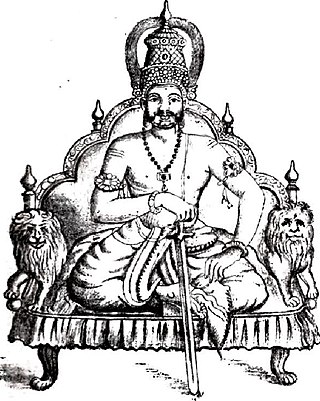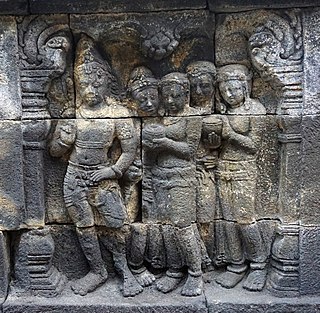| Menaka | |
|---|---|
 Menaka seduces Vishvamitra, painting by Raja Ravi Varma | |
| Affiliation | Apsara |
| Abode | Svarga |
| Genealogy | |
| Children |
|
Menaka (Sanskrit : मेनका, lit. 'incomparable', IAST : Menakā) [2] is an apsara (heavenly nymph) in Hindu mythology. [3]
| Menaka | |
|---|---|
 Menaka seduces Vishvamitra, painting by Raja Ravi Varma | |
| Affiliation | Apsara |
| Abode | Svarga |
| Genealogy | |
| Children |
|
Menaka (Sanskrit : मेनका, lit. 'incomparable', IAST : Menakā) [2] is an apsara (heavenly nymph) in Hindu mythology. [3]
Menaka was born during the churning of the ocean by the devas and asuras. She was one of the most mesmerising apsaras (celestial nymphs) in the three worlds, with quick intelligence and innate talent, but desired a family.

Vishvamitra was a prominent Hindu sage, who frightened the devas with his powers. Indra, the king of the devas, thus sent Menaka from heaven to earth to seduce him and break his meditation. Menaka successfully incited Vishvamitra's lust and passion, and broke his meditation. However, she fell in love with him herself and a baby was born to them, who later grew in Sage Kanva's ashram and came to be called Shakuntala. Later, Shakuntala fell in love with King Dushyanta and gave birth to a child called Bharata, who in Hindu tradition, lent his name to the country. [4]
When Vishvamitra realized that he had been tricked by Indra, he was enraged. But he merely cursed Menaka to be separated from him forever, for he loved her as well and knew that she had lost all devious intentions towards him.
In the Mahabharata's Pauloma Parva, it is stated that Menaka had a daughter with the gandharva Vishvavasu. She was ashamed of giving birth to the child, so she left her in front of sage Sthulakesha's hermitage. The sage adopted the child and named her Pramadvara, who later married Ruru, a descendant of Bhrigu. [5]

Apsaras are a member of a class of celestial beings in Hindu and Buddhist culture. They were originally a type of female spirit of the clouds and waters, but, later play the role of a "nymph" or "fairy". They figure prominently in the sculptures, dance, literature and paintings of many South Asian and Southeast Asian cultures.

Svarga, also known as Swarga, Indraloka and Svargaloka, is the celestial abode of the devas in Hinduism. Svarga is one of the seven higher lokas in Hindu cosmology. Svarga is often translated as heaven, though it is regarded to be dissimilar to the concept of the Abrahamic Heaven.

Vishvamitra is one of the most venerated rishis or sages of ancient India. Vishvamitra is one of the seven Brahmarshi. According to Hindu tradition, he is stated to have written most of the Mandala 3 of the Rigveda, including the Gayatri Mantra (3.62.10). The Puranas mention that only 24 rishis since antiquity have understood the whole meaning of —and thus wielded the whole power of — the Gayatri Mantra. Vishvamitra is supposed to have been the first, and Yajnavalkya the last.
Ambalika is the queen of Kuru Kingdom in the Hindu epic Mahabharata. The youngest daughter of Kashya, the King of Kashi and Kausalya, Ambalika is abducted by Bhishma during her svayamvara ceremony, and becomes the wife of Vichitravirya, the King of Hastinapura. She is the mother of Pandu and the grandmother of Pandavas.

Urvashi is the most prominent apsara mentioned in the Hindu scriptures like the Vedas, the epics Ramayana and Mahabharata, as well as the Puranas. She is regarded as the most beautiful of all the apsaras, and an expert dancer.

Shakuntala is a heroine in Indian literature, best known for her portrayal in the ancient Sanskrit play Abhijnanashakuntalam, written by the classical poet Kalidasa in the 4th or 5th century CE. Her story, however, originates in the Hindu epic, the Mahabharata, where she appears in the Adi Parva. In both narratives, Shakuntala was the daughter of the sage Vishwamitra and the celestial nymph Menaka. Abandoned at birth, she was raised by the sage Kanva in a forest hermitage. Years later, she fell in love with King Dushyanta and married him. After a series of misfortunes, she became the mother of Bharata, a celebrated emperor of India

Dushyanta is a king of the Chandravamsha (Lunar) dynasty featured in Hindu literature. He is the husband of Shakuntala and the father of Bharata. He appears in the Mahabharata and in Kalidasa's play, Abhijnanashakuntalam.

Naranarayana, also rendered Nara-Narayana, is a Hindu duo of sage-brothers. Generally regarded to be the partial-incarnation (aṃśa-avatara) of the preserver deity, Vishnu, on earth, Nara-Narayana are described to be the sons of Dharma and Ahimsa.

Yayati is an emperor in Hindu tradition. He is described to be a Chandravamsha king. He is regarded to be the progenitor of the races of the Yadavas and the Pandavas.

Hindu mythological wars are the wars described in the Hindu texts of ancient India. These wars depicted both mortals of great prowess as well as deities and supernatural beings, often wielding supernatural weapons of great power. Hindu teachings prescribe war as the final option, to be employed only after all peaceful methods are exhausted. Participation in righteous war, or dharmayuddha, was said to be honourable and was a principal duty of the Kshatriya or the warrior varna, and victory in such wars was regarded as a matter of honour.

Bharata is a legendary emperor featured in Hindu literature. He is a member of the Chandravamsha dynasty, and becomes the Chakravarti. He is regarded to be the ancestor of the Pandavas, the Kauravas, Brihadhrata, and Jarasandha.

Rambha is one of the prominent apsaras, the celestial nymphs of Svarga, in Hindu mythology. She is extolled to be unrivalled in her accomplishments in the arts of dancing, music, and beauty.

Tilottama, is an apsara described in Hindu mythology.

Pururavas is a character in Hindu literature, a king who served as the first of the Lunar dynasty.

Chyavana was a sage (rishi) in Hinduism. He was a son of Bhrigu, also known as Bhrigu Varuni in the Upanishads, and is known for his rejuvenation through a special herbal paste or tonic known as chyavanaprasham, which was prepared by the Ashvins. According to the Mahabharata, he was powerful enough to oppose the celestial thunderbolt (vajra) of Indra, and was responsible for the Ashvins getting their share of the sacrificial offerings. He created an asura, Mada, to achieve it.
The kalakeyas or kalakhanjas are a sect of danavas in Hindu mythology, referring to the children of Kashyapa and Kala. Sixty-thousand kalakeyas are said to exist, and they are described to fight under the asura banner, under Vritra, as well as other rulers.

Amaravati is the capital city of Svarga, the realm of Indra, the king of the devas, in Hinduism, Buddhism, and Jainism. It is also called Devapura, ‘city of the devas’ and Pūṣābhāsā, ‘sun-splendour’ in the Puranas.
Ghritachi is a prominent apsara in Hindu mythology. She is known for her beauty and seduction of many men, both divine and human, and for becoming the mother of their children.

Matali is the charioteer of Indra, the king of the devas, in Hinduism. He also acts as the messenger of Indra, inviting Dushyanta to help the deity in his war against the asuras in the Abhijnanashakuntalam. In the Padma Purana, Matali engages in a philosophical discourse with King Yayati regarding the nature of the soul, old age, and other concepts.